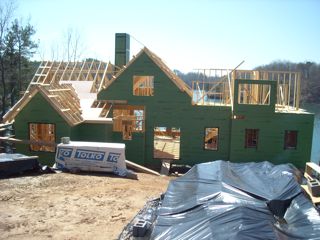How Hard Will It Be for Builders to Meet the New Georgia Energy Code?

 As you may have heard, we have a new energy code here in Georgia that’s one of the most progressive in the country. One of the new requirements, which to my knowledge no other state has, is that all new homes must be tested with a Blower Door and meet a threshold for infiltration rate. So, how hard will it be for builders to hit this mark?
As you may have heard, we have a new energy code here in Georgia that’s one of the most progressive in the country. One of the new requirements, which to my knowledge no other state has, is that all new homes must be tested with a Blower Door and meet a threshold for infiltration rate. So, how hard will it be for builders to hit this mark?
As you may have heard, we have a new energy code here in Georgia that’s one of the most progressive in the country. One of the new requirements, which to my knowledge no other state has, is that all new homes must be tested with a Blower Door and meet a threshold for infiltration rate. So, how hard will it be for builders to hit this mark?
First, let’s get the definitions out of the way. The threshold is 7 air changes per hour with a pressure difference across the building envelope of 50 Pascals (ACH50). The Blower Door test measures the rate of air flow through the fan creating the pressure difference in cubic feet per minute (cfm). One air change occurs when the number of cubic feet of air thrown out by the fan equals the volume inside the house. (If you’ve been reading my articles for a while, you may know I’m not a fan of using ACH, but we have to work with the standard as written.)
One of our HERS raters recently sent me a batch of 7 HERS rating files for two different builders who aren’t trying to qualify for ENERGY STAR. One is just trying to find out where they stand; the other is part of a research project. They’re typical builders in Georgia, not a part of any green building or energy efficiency programs, so how close do you think they are to passing the 7 ACH50 requirement right now?
out where they stand; the other is part of a research project. They’re typical builders in Georgia, not a part of any green building or energy efficiency programs, so how close do you think they are to passing the 7 ACH50 requirement right now?
Well, the numbers ranged from a low of 2.8 ACH50 to a high of 5.1 ACH50, with an average of 4.2 ACH50. Based on this admittedly small sample, it looks like builders shouldn’t have trouble meeting the requirement. The truth is that 7 ACH50 is a pretty lax standard. It’s a good starting point for Georgia because, I believe, most builders will meet it pretty easily, with little or no extra air sealing needed after the initial Blower Door test. If they’re not passing the 7 ACH50 standard, then there’s some serious air leakage that needs to be fixed.
The house that I built came in at 1.7 ACH50, and I’d never even seen or done a Blower Door test at the time. Yes, it was built out of structural insulated panels (SIPs), but you still have to pay attention to the air sealing details. The Passive House program, which puts a premium on a superinsulated, supertight building envelope, requires an infiltration rate of 0.7 ACH50 or less.
The implementation of the testing requirement was delayed six months but goes into effect with all new homes permitted on 1 July 2011 or later. Builders, what are your thoughts about this? Raters and DET verifiers, send us your data. I’d like to see more numbers.
The testing must be done by what the state of Georgia calls a certified Duct and Envelope Tightness (DET) verifier. HERS raters and BPI Building Analysts automatically qualify, and you can take our HERS rater class next month. There’s also a class being offered just for the DET verifier certification, and Energy Vanguard will be offering these classes in the near future. Contact us for details.
This Post Has 5 Comments
Comments are closed.

Suggestion: Great topic and
Suggestion: Great topic and brings up a request from my office Allison. Put the 7 ACH50 into perspective in a short article. Write it in “Builder Language”. In other words you would not meet with the builder and say something like, “Mr. Builder, your home reached 4.8 ACH50.” Most builders (and their clients) don’t understand that scale at all.
How do does the rater speak “Builder Language”?
What terms does he use to put something like air leakage ratio into perspective?
Hey Allison. Agreed. The 7
Hey Allison. Agreed. The 7 ACH50 isn’t going to be that hard to achieve. That being said, the duct leakage requirement is another story. Builders are going to have MAJOR problems meeting it.
Gary: Good
Gary: Good idea! I think I’ve got a lot of it scattered around the EV blog already, but putting it in one place would be helpful. It’ll also be helpful when I have data from more than 2 builders.
Jeffrey: Yeah, meeting the duct leakage threshold is definitely going to be more difficult for builders to do. Seems like I’ve written a thing or two about the HVAC industry and ducts in this space before.
As raters, we also do
As raters, we also do completed homes. We have recently tested some just completed homes for the homeowners, not the builders. We were unable to pressurize to 50 ACH. Everything leaked and these were very high end houses with large price tags. I love that these changes are coming. I’m in VA, can’t wait for it to be a requirement here. But I agree, I have yet to test a duct system and had good results on the first try. However, every single HVAC guy tells me that they are the exception and their work is flawless. If that is the case, just who is installing these ducts?
LOL, Elizabeth – I think most
LOL, Elizabeth – I think most all appreciate that the HVAC guys have had carte blanche and have been in a world of their own … methinks, there is about to be a huge amount of lawsuits that’ll reform the industry.
On another point, unfortunately, Builders haven’t a clue as to what their HVAC guys are doing and will disavow any liability for their subcontractor’s efforts …(“Builders are going to have MAJOR problems meeting it.”) … for the most part, Builders have no clue, nor do they want to … due to preferred ignorance, they leave it all to their HVAC contractor, many of whom are about to fry.